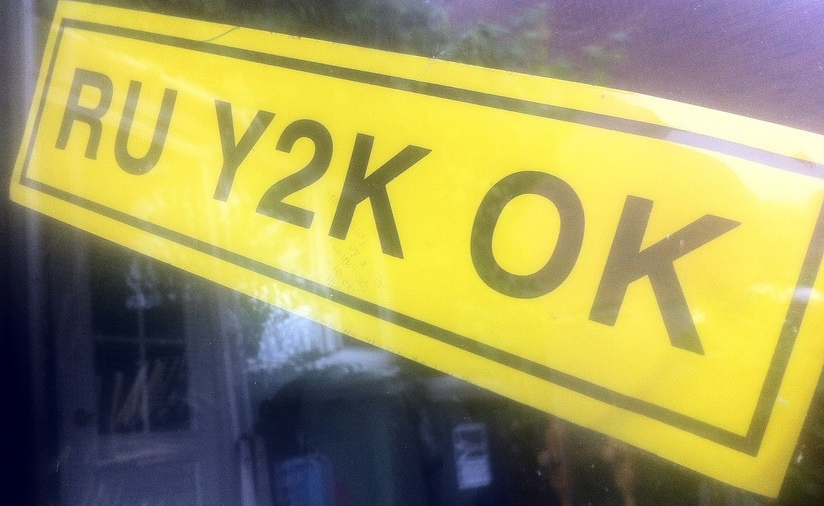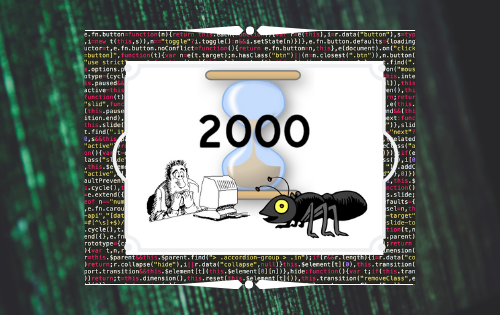Y2K is an acronym that stands for Year((Y) Two(2) Thousand(K). People believed that computers would stop working or go berserk. Some even thought the world would end when the clock turned over on 1-1-2000. There was a lot of hysteria and a lot of jobs for computer programmers. Then 9-11-2001 happened and most people forgot about Y2K.
The Logo Created by The President’s Council on the Year 2000 Conversion, for use on the now defunct Y2K.gov.
Glitch?
Was it a glitch? “A minor malfunction, mishap, or technical problem; a snag: a computer glitch; a navigational glitch; a glitch in the negotiations. 2. A false or spurious electronic signal caused by a brief, unwanted surge of electric power.”1 No, because a glitch is a “minor malfunction.” This was not minor.
Computer Virus?
Was it a computer virus? “a segment of self-replicating code planted illegally in a computer program, often to damage or shut down a system or network.”2 C
Y2K Defined
Seems like, Y2K could mean two things, but the second meaning was sort of scary. “1. Of or relating to the year 20002. 2. Of or relating to defect in the code of a computer program caused when a year is represented by its last two digits only and the program interprets that year as falling inclusively between 1900 and 1999 instead of between 2000 and 2099: Y2K compliance; Y2K testing.”3

So, What Did This Really Mean?
There was a defect in a lot of computer code. First, companies didn’t buy new computers every year or even every several years. At the time, businesses owned equipment and they viewed a computer as just another piece of equipment. Businesses often used their equipment until the equipment wore out and computers could be very expensive to get or to replace. A lot of the computers still had fine mechanical parts
However, the software needed
The Y2K Problem Was Absolutely Complex. An Explanation.
The Y2K problem originated as a software bug – “ A software bug is an error, flaw, failure or fault in a computer program or system that causes it to produce an incorrect or unexpected result, or to behave in unintended ways.”4
First, the software bug was noticed in 1958, but most people didn’t pay attention to the problem. By the mid to late 1990s, there was a frenzy to get the bug fixed.
Common Usage
In the 1900s, the common way to refer to a year was by using the last two numbers. ’85, ’90, and ’96 were ways to refer to 1985, 1990, and 1996. No one even thought about the year 2000 even being a problem
Excessive Cost of Memory Space
Also, computer memory was expensive compared to now. “Early core memory cost one dollar per bit.”5
Eight bits equaled a byte. A byte represented a letter of the alphabet or a single number. In more understandable terms, the equivalent of one letter or one number in core memory would cost $8.00. So, programmers used whatever means necessary to conserve core memory.
Saving Space
To save space, dates were often coded for two changeable places for the month, two changeable places for the day, and two changeable places for the year – MMDDYY. The first two spaces for the year were either not used or “hard coded” as 19. It was assumed that by the turn of the century everything would be updated. The updates to the computer code never happened.

Problem Corrected, Finally
Unless something was done when the year 2000 happened, a lot of computers would operate like it was 1900. No one knew what would happen, but the general consensus was that the result would be a mess. Steps to correct the problem did not really begin in earnest until the late 1990s. Talk about waiting until the last minute. People went to sleep on December 31, 1999, not knowing what the next day would bring. Nothing significant happened. Measures had been taken to prevent a major problem.
The next year 9-11 happenened and everybody forgot about Y2K.
What did Y2K teach me? It did not teach me that there was no problem. It did not teach me to look the other way when a problem exists. I know that computers are not magic. Above all, I learned, that when people do their job, you hardly notice there is a problem at all. Thank you to all the Y2K programmers that did their job.
More Information
A good place to get information about computers is the Internet. “
Bibliography
1“Glitch.” The Free Dictionary. Accessed March 21, 2019. https://www.thefreedictionary.com/glitch
2 “Computer Virus.” The Free Dictionary. Accessed March 21, 2019. https://www.thefreedictionary.com/computer+virus.
3 “Y2K.” The Free Dictionary. Accessed March 21, 2019. https://www.thefreedictionary.com/Y2K.
4 “Software bug.” The Free Dictionary. Accessed March 21, 2019. https://encyclopedia.thefreedictionary.com/software+bug.
5 “Year 2000 Problem.” Wikipedia. March 16, 2019. Accessed March 21, 2019. https://en.wikipedia.org/wiki/Year_2000_problem#The_need_for_bit_conservation.
6“Year 2000 Problem.” Wikipedia. Accessed March 22, 2019. https://en.wikipedia.org/wiki/Year_2000_problem.
7“Timeline Highlights.” Computer History Museum. Accessed March 22, 2019. https://www.computerhistory.org/timeline/.



Leave a Reply